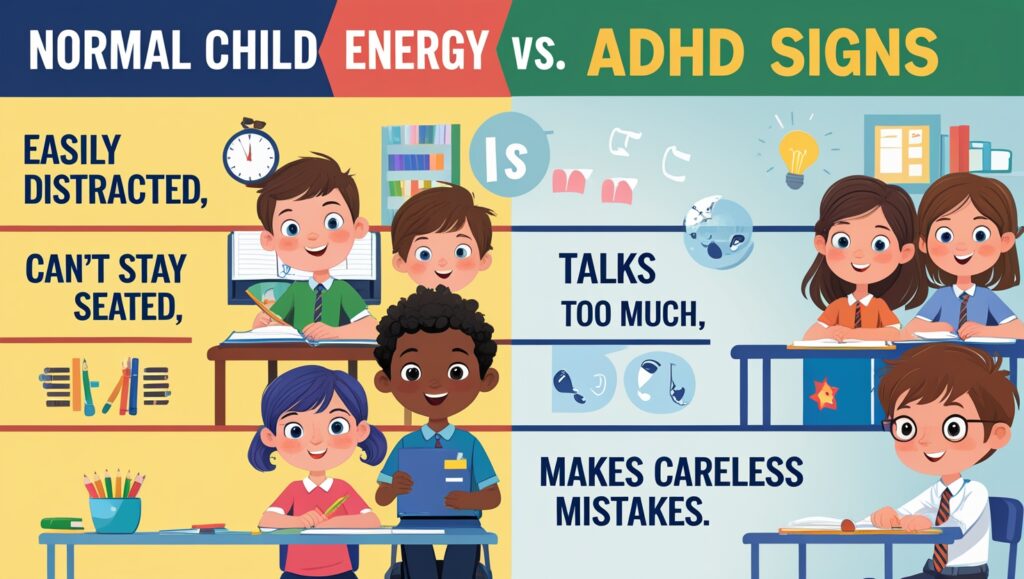Is your child full of energy and struggles to concentrate—or is it something more? It’s natural for children to be active and occasionally unfocused, but consistent behavioral patterns could signal something deeper, like Attention Deficit Hyperactivity Disorder (ADHD). In this complete guide, we’ll explore how to recognize ADHD symptoms in children, how long to observe them, and what to do next as a concerned parent or caregiver.
What Is ADHD?

How to Recognize ADHD Symptoms in Children, .ADHD is a neurodevelopmental disorder that typically begins in childhood and can persist into adulthood. It affects a child’s ability to focus, stay organized, sit still, and control impulsive behavior. The three main types of ADHD are:
- Inattentive type (difficulty paying attention)
- Hyperactive-impulsive type (excessive movement and impulsivity)
- Combined type (a mix of both symptoms)
Step 1, Observe Their Attention Span
One of the earliest signs of ADHD is a poor attention span. While all young children can be distracted, those with ADHD:
- Struggle to stay focused during tasks or play
- Appear not to listen even when spoken to directly
- Frequently lose items like toys, homework, or books
- Have difficulty following through on instructions
- Make careless mistakes, particularly in schoolwork
As A Parents What Can Do:
- Use short, clear instructions
- Break tasks into smaller, manageable steps
- Introduce visual schedules to guide daily routines
Step 2: Evaluate Energy Levels and Impulsivity
All kids have bursts of energy, but children with ADHD display excessive hyperactivity or impulsivity that interferes with their day-to-day lives.
Common Signs
- Constant fidgeting or squirming when seated
- Difficulty staying seated in class or at the dinner table
- Running or climbing in inappropriate situations
- Talking excessively or blurting out answers
- Interrupting others’ conversations or games
Girls are more likely to show inattentive symptoms, such as daydreaming or quiet distraction. Boys often exhibit hyperactive behaviors, like restlessness and loud talking.

What You Can Try:
- Use mindfulness exercises like deep breathing or quiet time
- Provide structured physical activity outlets (e.g., sports, dance)
- Praise self-control and patience
Step 3: Consider the Duration
How to Recognize ADHD Symptoms in Children: ADHD is not a temporary condition. If you’ve observed signs of hyperactivity or inattention for more than six months, it’s worth investigating further.
Key Question:
Have these behaviors been consistent and disruptive over the past six months?
If yes, and they’re affecting school performance, friendships, or home life, it could point toward ADHD.
Step 4: Track the Settings
Where do the symptoms appear?
- If your child only displays these behaviors at home or only at school, other factors—such as environment, family dynamics, or teaching style—may be at play.
- If your child only displays these behaviors at home or only at school, other factors—such as environment, family dynamics, or teaching style—may be at play.
ADHD usually presents across multiple settings. Consistency is a major sign.
Step 5: Assess the Impact on Daily Life
Children with ADHD often experience:
- Poor school performance despite average or above-average intelligence
- Trouble making or keeping friends
- Frequent conflicts with siblings, classmates, or teachers
- Low self-esteem due to constant corrections or punishments
Proactive Steps
- Meet with teachers to get feedback on classroom behavior
- Encourage social skill-building through roleplay or group activities
- Use reward systems to motivate positive behavior
Step 6: Seek a Pediatric Evaluation
If multiple symptoms are observed consistently across different environments for more than six months, schedule a visit with your child’s pediatrician.
They may:
- Conduct a behavioral assessment
- Refer you to a child psychologist or psychiatrist
- Rule out other causes like hearing issues, sleep problems, or learning disorders
Fun Fact: Children whose mothers smoked during pregnancy are more than twice as likely to be diagnosed with ADHD.
Causes and Risk Factors of ADHD symptoms in children
While the exact cause of ADHD is not known, several factors may contribute:
- Genetics (it often runs in families)
- Prenatal exposure to tobacco, alcohol, or drugs
- Premature birth or low birth weight
- Environmental toxins, such as lead exposure
Common Questions Parents Ask
Is it ADHD or just high energy?
High energy is normal in kids, especially preschoolers. ADHD involves disruption of normal function over time in multiple settings.
Can diet cause ADHD?
There’s no proof diet causes ADHD, but some foods may worsen symptoms (like sugar or artificial dyes in sensitive children).
Can my child outgrow ADHD?
Some children learn to manage symptoms as they grow, but many continue to face challenges into adolescence or adulthood.

ADHD Management and Solutions
Behavioral Therapy
Especially effective for younger children, therapy focuses on teaching them self-control, organization, and coping skills.
Parent Training
Programs help caregivers respond constructively to behaviors and create structure at home.
School Support
An Individualized Education Plan (IEP) or 504 Plan can provide academic support and accommodations.
Medication
In some cases, pediatricians may recommend stimulant or non-stimulant medications. Always discuss the pros and cons carefully.
Final Thoughts
Recognizing ADHD early empowers you to support your child’s development, confidence, and happiness. If you see consistent signs—like inattention, excessive energy, or social struggles—don’t hesitate to talk to a professional. With the right tools, support, and understanding, children with ADHD can thrive. “For more support, CHADD offers resources for families managing ADHD.”
If you found this guide helpful, share it with fellow parents or teachers. For more family-focused tips on learning, tech tools, and child development, visit our blog at IscoBlog.com.
Stay informed. Stay empowered. Your child’s future matters.
read our latest post,
investing in high yields bonds with real life proof the easiest and profitable investment in 2025




